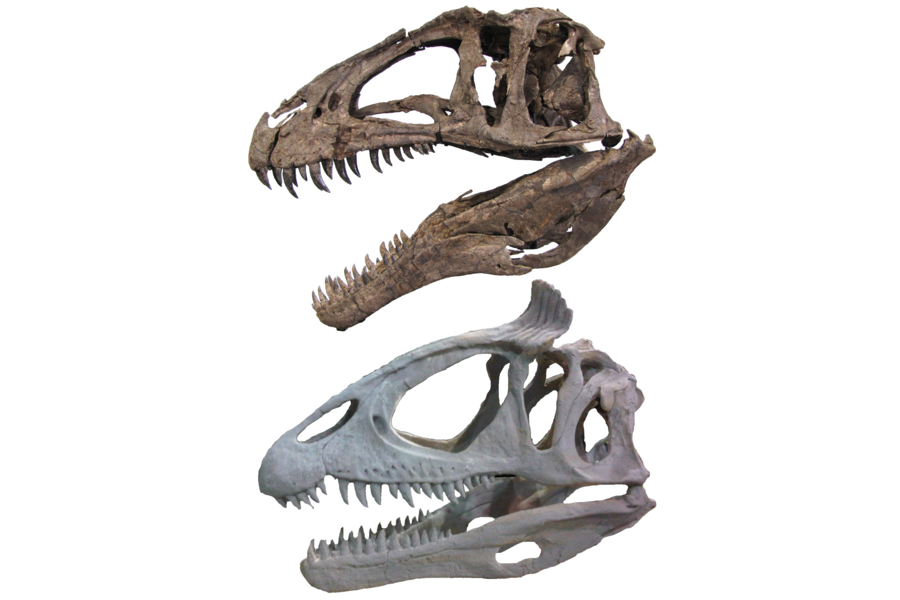Could ornamented skulls have helped dinosaurs get big?
Loading...
During the age of the dinosaurs, that horned look was so in.
Tyrannosaurus, Allosaurus, and Giganotosaurus were among the most humongous predatory beasts that ruled the prehistoric Earth, and they all had strange bony structures sticking out of their skulls.
But these cranial ornaments likely weren't just the fashion statements of dinosaur kings, say paleontologists. They might also have something to do with why these fearsome predators came to be so huge.
Theropod dinosaur lineages with horns, crests, knobs and other bony cranial ornamentation evolved to gigantic body sizes about 20 times faster than those without such flashy adornments, according to new research published Tuesday in the journal Nature Communications.
Study lead author Terry Gates, a paleontologist at North Carolina State University and the North Carolina Museum of Natural Science, normally studies the crests of duckbilled dinosaurs. So when he was looking at a different group of dinosaurs, the two-footed predatory theropods, "of course I was looking at the ornamentation on them because that's what I tend to look at on dinosaurs," he tells The Christian Science Monitor in an interview.
That's when Dr. Gates noticed a strange pattern: a lot of the larger theropods had bony cranial ornamentation, but he didn't see any on the smaller theropods. Gates' interest was piqued so, along with two other paleontologists, he began to collect dinosaur heads.
After examining 111 theropod dinosaur skulls, the team realized they were onto something. All the theropods that weighed under about 80 pounds had no evidence of bony cranial ornamentation. And just 2 of the largest theropod dinosaurs lacked crests, horns or knobs on their skulls.
And, says Gates, "it turns out that the optimum body size for ornamented theropods, according to our analysis anyway, is about 1,300 kilograms," or about 3,000 pounds. That's what a Volkswagen Beetle weighs.
But maniraptoran dinosaurs, a clade of theropod dinosaurs that includes modern birds, break that pattern. Only one group of animals in that clade has bony cranial ornamentation: the oviraptors.
The researchers thought, "maybe [the maniraptors] were just smaller body size," Gates says. "But they're not smaller body size. They obtained the same distribution of body sizes" as other theropod dinosaurs. Furthermore, "there was nothing about 'being' a raptor dinosaur, in terms of physiology or something of the nature that would dictate them not having the ornamentation," Gates says.
So why could this one group of theropod dinosaurs be bucking the pattern?
The answer may lie in feathers.
If the bony features were being used for some sort of signaling, the evolution of pennaceous (quilled) feathers might have helped fill that need. Many maniraptoran dinosaurs alive today (also known as birds) have feathery crests and other sorts of cranial ornamentation made from feathers.
This isn't a new idea, says Darren Naish, a paleontologist at the University of Southampton who was not part of this research. Dr. Naish's own research suggests that theropods switched over from bony display structures to complex feathered ones, as evolution perhaps favored the feathers.
"Feathers are 'superior' to bony head crests in some ways," Naish explains in an email to the Monitor. "They can be easily stowed and concealed, they're replaced every year and regrow if damaged, they're lightweight and cheap to grow, and so on."
Fashion forward to big bodies?
"It's not surprising, of course, that ornamentation would generally be correlated with size," Kevin Padian, curator at the Museum of Paleontology at the University of California, Berkeley, writes in an email to the Monitor. "Size correlates with the vast majority of other biological variation."
But could the relationship between bony horns and crests and theropod size mean one is driving the other?
"There definitely is a possibility that having ornaments just leads them down a path to become larger," perhaps through social interaction, Gates says.
Or perhaps both ornamentation and large body size were adaptations to the same sort of environment, he says. For example, an open landscape may have made it so the animals needed more dramatic visual cues to communicate with each other and allowed them to grow larger at the same time.
Another possibility is that large body size necessitated bony signaling structures, suggests Thomas Holtz Jr., a paleontologist at the University of Maryland who was not part of the study. For example, he writes in an email to the Monitor, "maybe smaller dinosaurs made greater use of motions (dances and the like), but at larger body sizes a static method of display was energetically easier."
But, Gates says, there is no way to tell what is driving this correlation at this point.
To better understand if there is a relationship between cranial ornamentation and body size, Gates hopes to take a closer look at other groups of dinosaurs. Perhaps diet plays a role, he suggests, and looking at herbivorous dinosaurs could help sort that out.








